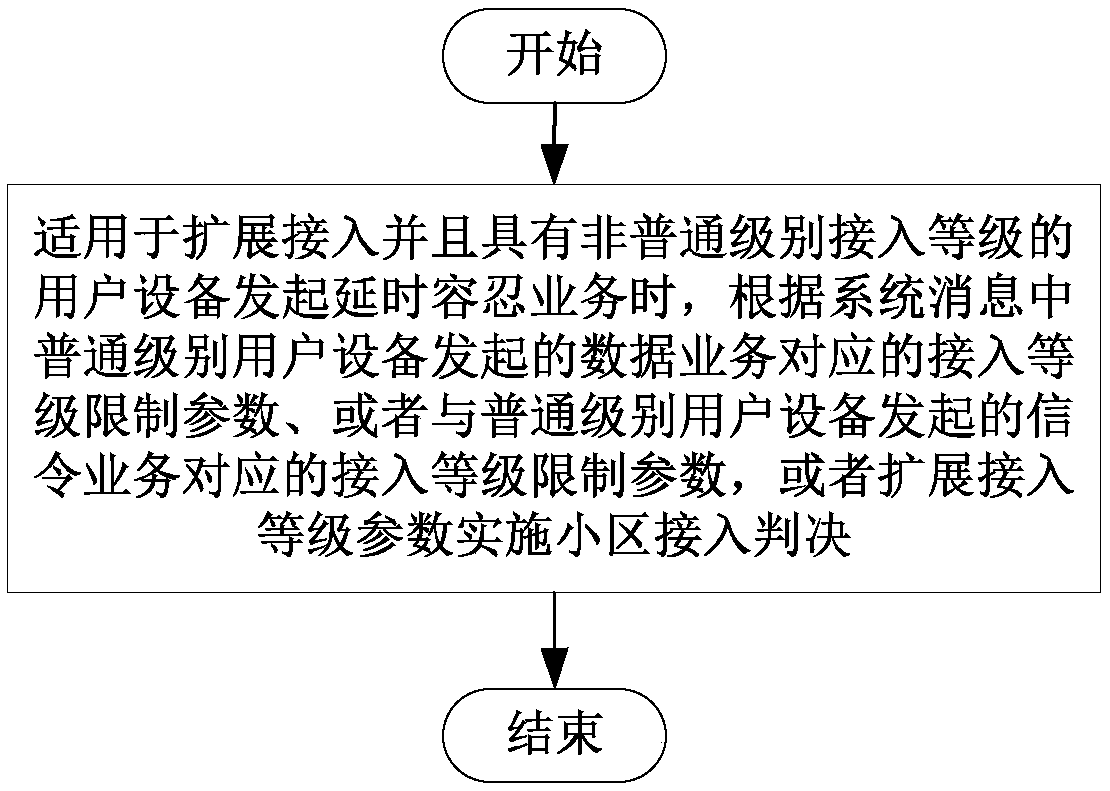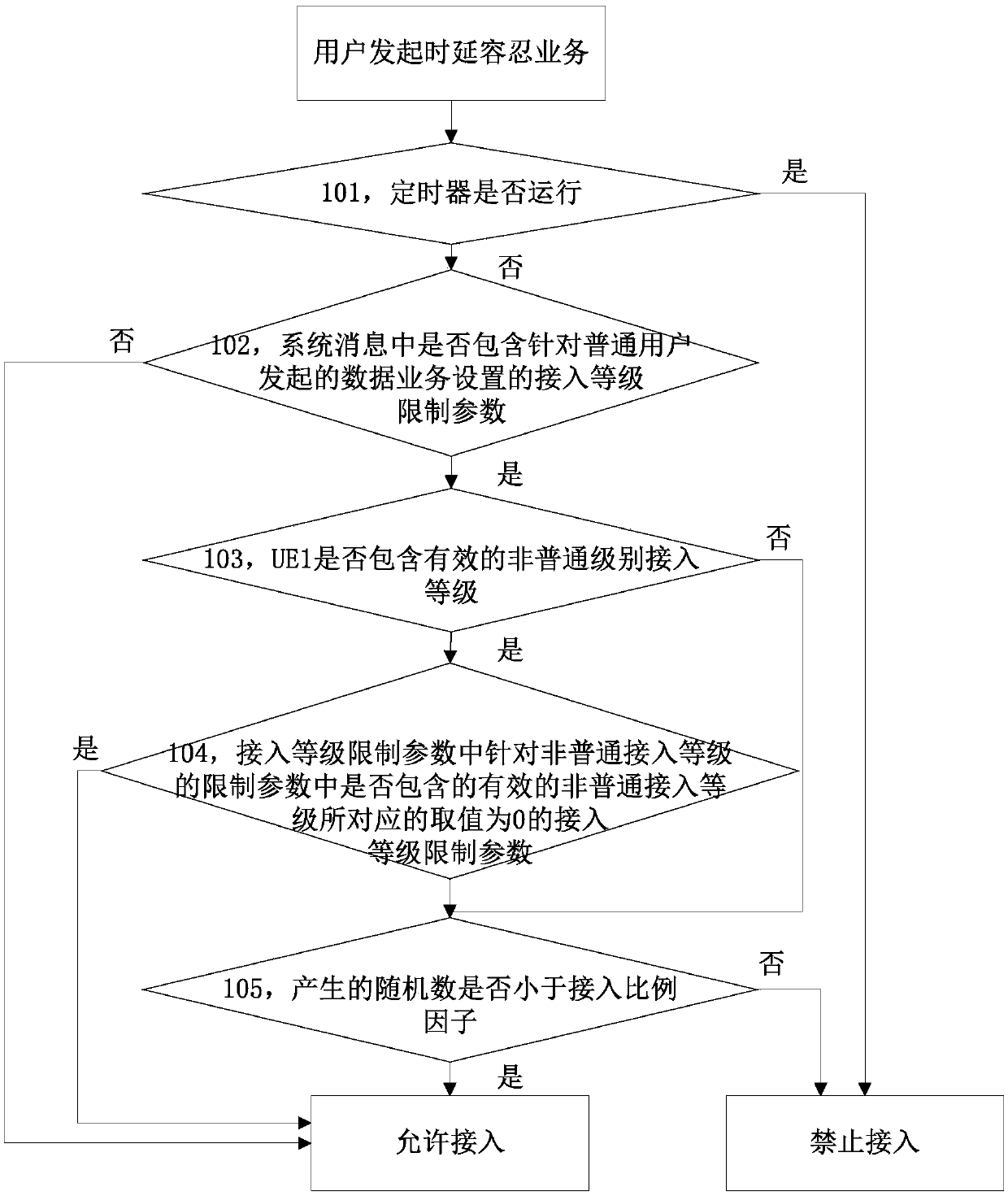A method and user equipment for performing access control
A technology for user equipment and access control, which is applied in the directions of access restriction, wireless communication, electrical components, etc., and can solve the problem of no UE access judgment scheme.
- Summary
- Abstract
- Description
- Claims
- Application Information
AI Technical Summary
Problems solved by technology
Method used
Image
Examples
specific Embodiment 1
[0038] In the LTE system, UE1 resides in cell 1 under the jurisdiction of base station 1 and is in an idle state. A valid EAB is configured in the USIM card of UE1, and the EAB configuration may be set to True. In addition, the USIM card of UE1 indicates that the access class (Access Class) of the UE is 11.
[0039] When UE1 needs to initiate a delay tolerant (Delay Tolerant) service or a low priority (LowPriority) service, the non-access stratum NAS (non-Access Stratus, NAS for short) layer of UE1 sends the establishment reason ( Establishment Cause) is the cause of delay tolerance or low priority. The AS layer of UE1 implements the access decision process as follows: figure 2 Shown:
[0040] Step 101: UE1 judges whether the waiting time timer (T302) or the access restriction timer set for delay tolerance or low-priority services is running, and if it is running, UE1 judges that access to the current cell is prohibited; If neither of the two timers is running, step 102 is...
specific Embodiment 2
[0050] In the LTE system, UE2 resides in cell 2 under the jurisdiction of base station 2 and is in an idle state. A valid EAB is configured in the USIM card of UE2. In addition, the USIM card of UE2 indicates that the access class of the UE is 12, that is, the Access Class is 12.
[0051] When UE2 needs to initiate a delay tolerant (Delay Tolerant) service or a low priority (LowPriority) service, the NAS layer (non-Access Stratus, non-access stratum) of UE2 sends the establishment reason (Establishment Cause) to the AS layer of UE1 ) for delay tolerance, or low priority reasons. The AS layer of UE2 implements the access decision process as follows: image 3 Shown:
[0052] Step 201: UE2 judges whether the waiting time timer (T302) or the access restriction timer set for delay tolerance or low priority services is running. If it is running, UE2 judges that accessing the current cell is forbidden (consider access to the cell as barred); if the two timers are not running, go t...
specific Embodiment 3
[0061] In the LTE system, the UE3 resides in the cell 3 under the jurisdiction of the base station 3 and is in an idle state. A valid EAB is configured in the USIM card of UE3. In addition, the USIM card of UE3 indicates that the access class of the UE is 13, that is, the Access Class is 13.
[0062] When UE3 needs to initiate a delay tolerant (Delay Tolerant) service or a low priority (LowPriority) service, the NAS layer (non-Access Stratus, non-access stratum) of UE3 finds that UE3 has an effective access class AC 13, Therefore, the establishment reason sent by the NAS layer of UE3 to the AS layer of UE3 is the data service (MO-Data) initiated by the user, or the signaling service (MO-Signalling) initiated by the user. After receiving the establishment reason of the new service, the NAS layer of UE3 performs access judgment according to the corresponding access restriction parameters in the system message, and judges whether the UE can initiate random access and establish an...
PUM
 Login to View More
Login to View More Abstract
Description
Claims
Application Information
 Login to View More
Login to View More - R&D
- Intellectual Property
- Life Sciences
- Materials
- Tech Scout
- Unparalleled Data Quality
- Higher Quality Content
- 60% Fewer Hallucinations
Browse by: Latest US Patents, China's latest patents, Technical Efficacy Thesaurus, Application Domain, Technology Topic, Popular Technical Reports.
© 2025 PatSnap. All rights reserved.Legal|Privacy policy|Modern Slavery Act Transparency Statement|Sitemap|About US| Contact US: help@patsnap.com



